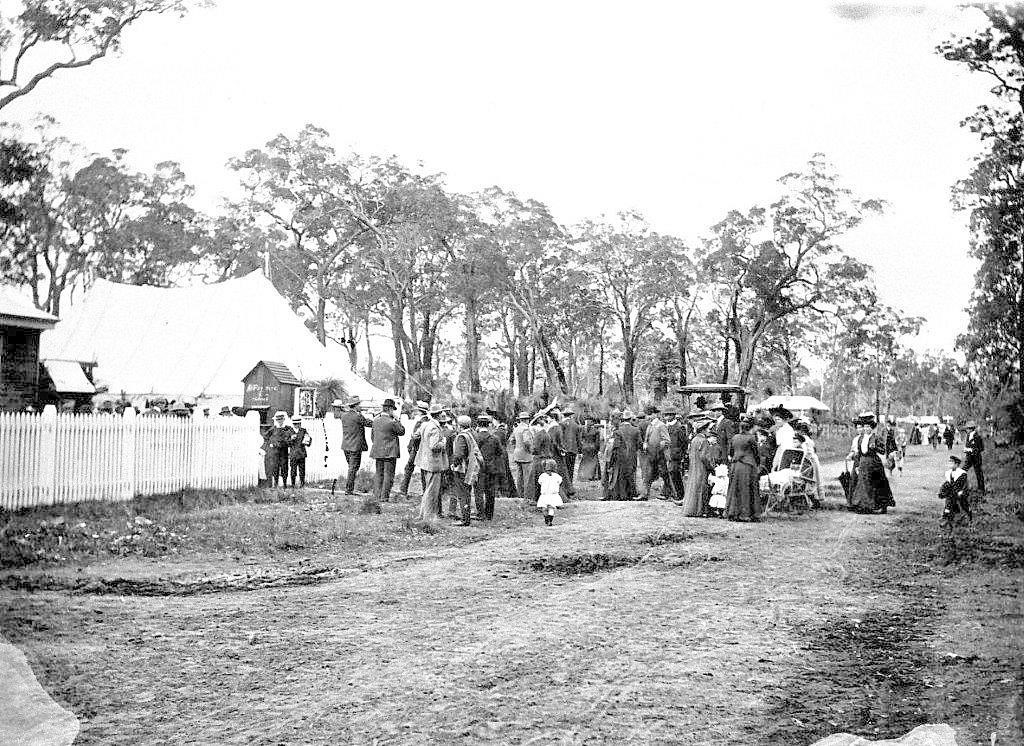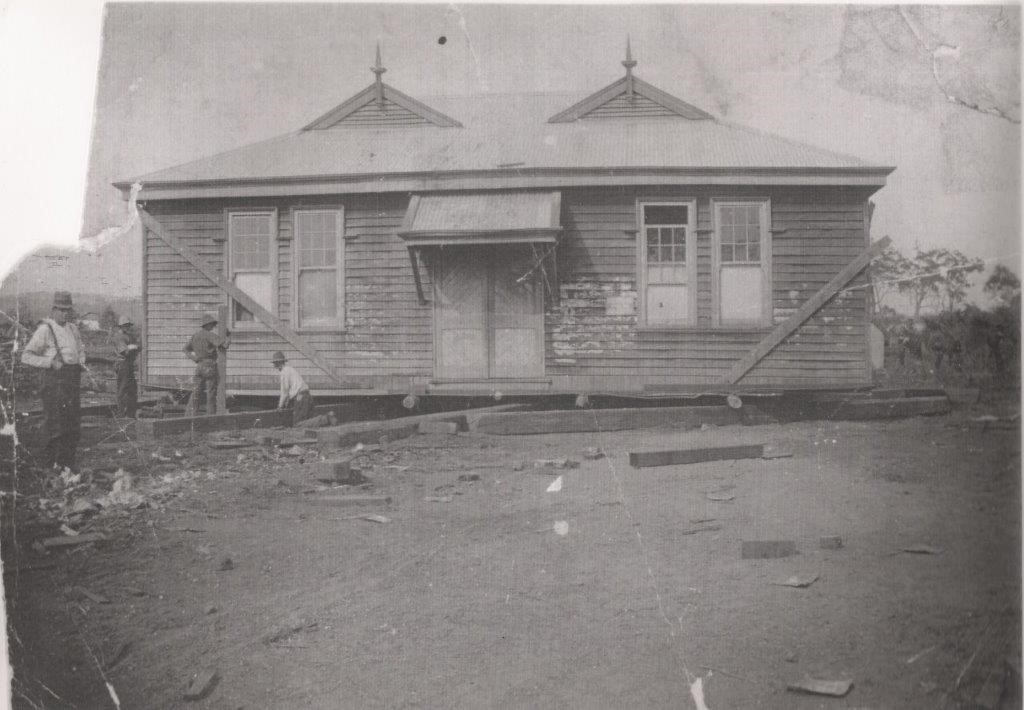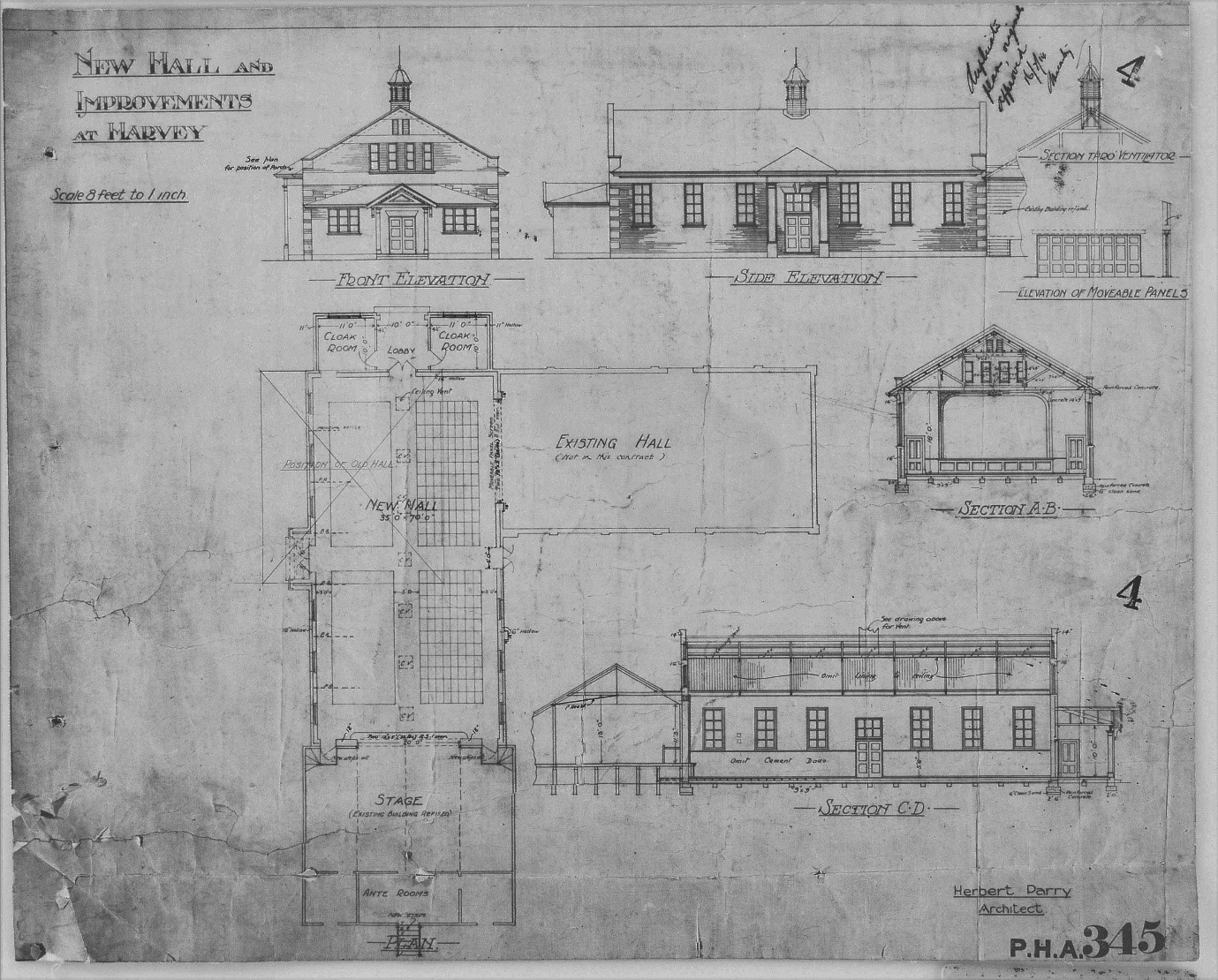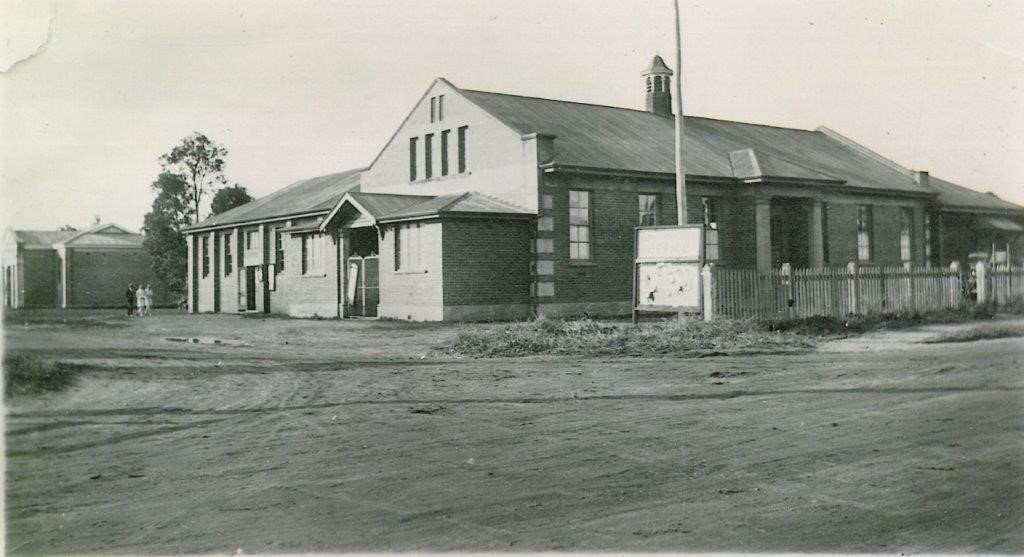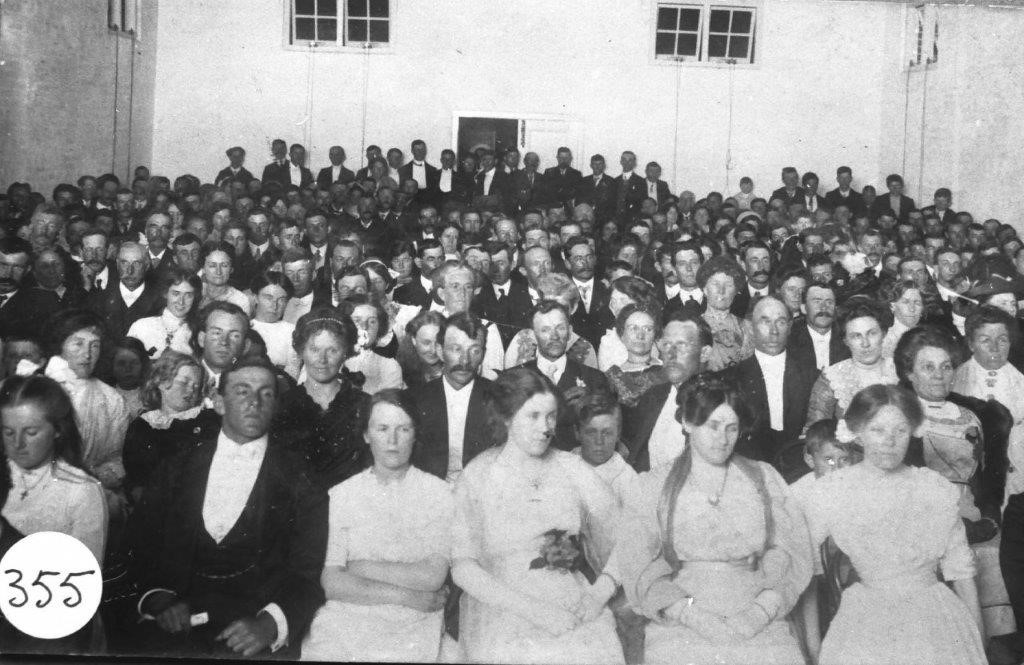By Heather Wade 2020
Since 1898 a public hall has stood on the corner of Young Street and Uduc Road, serving the growing population of Harvey and adapting as its needs and circumstances changed. The building has undergone many changes over the years, including two major incidents that severely tested the resolve of the small community.
The Harvey district had a slow beginning, with poor drainage causing major problems for its small population of farming families. However, the advent of the Perth to Bunbury railway in 1893 raised their prospects, providing a much-needed means of transport for sending their produce to market.
In 1895 the sub-division of blocks into 10-acre lots for citrus orchards, known as the Korijekup Fruit Settlement, drew new settlers from a range of backgrounds to the area. These included experienced fruit growers from Victoria as well as professional people such as doctors, who invested in properties and employed farm managers. The new citizens brought with them a determination to create a vibrant and supportive community and established a range of groups. At first, meetings took place in private houses but they soon realised that a public meeting place was needed.
1895 – The Wesleyan or Methodist Church at Harvey
The first building used for meetings and lectures in Harvey was the Methodist Church, commonly known as the Mission Hall which was situated behind WJ Sutton’s House [‘Kilrea’, now 56 Uduc Road]. It was constructed with a succession of busy bees organised by Messrs Knowles, James Clarke, James Taylor and WJ Sutton, on land donated by Sutton on part of his newly purchased town plot.[1] It was consecrated as a Wesleyan Church and the opening services were conducted on Sunday 15 September 1895 by the Rev. AC Plain of Bunbury.[2] It was used any time a public venue was required, including the early meetings of the Road Board, which were held alternately at Brunswick and Harvey from February 1896.[3] Catholics also used the building for Mass on Sundays.[4] The small wooden building went under a number of names including the Wesley Lecture Hall, Wesley Hall, Lecture Hall, or the Mission Hall and Dissenters’ Meeting Room. The Harvey Agricultural Alliance held its meetings there from 1895 until 1899 when they moved into the Agricultural Hall.
The first public building in Harvey was the Wesleyan or Methodist Church. Photo: Harvey Districts Historical Society, Federation Display.
In a nutshell.
Here is a brief outline of the history of Harvey Hall on the corner of Uduc Road and Young Street, listing the many changes that occurred over the years. A more detailed description follows:
-
- A wooden hall was built in 1899.
- It became too small and so a new brick hall was commenced in 1912. When the roof was ready to go on, two sides fell in. Building recommenced, the hall was opened in November 1912 and then it collapsed in June 1913, killing a girl.
- In 1914 a new brick hall was built where the old wooden hall had stood and is the basis of the Town Hall we know today. The old wooden hall was moved on rollers to form the stage and kitchen on the eastern side of the brick hall.
- In 1915 a Drill Hall, today known as the Lesser Hall, was built of brick and used the existing floor of the hall that fell down.
- In 1935 modifications and extensions were made to the hall that was built in 1914 and the Harvey Road Board office was added. The wooden hall was demolished.
1899 – The Harvey Agricultural Hall.
The Harvey Agricultural Alliance was formed in July 1894 as a farmers’ association to educate and discuss matters pertaining to agriculture in the area, but it soon became involved in lobbying government to improve local conditions. At its second meeting in August the need for a hall was discussed and the Government was to be petitioned.[5] In the Estimates of 1896/7 a grant of £250 was allocated to build an agricultural hall at the Harvey,[6] along with several others, as by then the Government recognised that a meeting place for rural communities had many benefits. A wooden hall was built on the corner of Uduc Road and Second Street (now called Young street) on land donated by Dr Harvey and vested in the Crown.[7]
A description of the proposed hall was reported in the Southern Times of 16 July 1898:
We have seen the plans which are being drawn up by Mr. E. W. Steere of the Harvey Agricultural Hall. The main hall will be 40ft by 25ft, there will be a main anti-room 21 x 9 and two committee rooms 9 x 9. The hall will be 13ft 6ins and by a simple arrangement a moveable platform will be erected at one end of the hall while provision will be made for a screen being placed in front of the platform in the event of the hall being required for entertainments.
In August 1898 the tender was accepted and the building was expected to be finished in three months.[8] A Ball was held in the unfinished hall in late October and voted a great success.[9] Several other functions, including a church service, were held before the official opening on 30 March 1899 by Mr Venn, the local MLA.[10]
The wooden Agricultural Hall built in 1899 (middle left), taken from the intersection of Uduc Road and Young street on the occasion of the Citrus Society’s Fruit Show. Photo: Harvey Districts Historical Society, Federation Display.
Within a fortnight of the opening, Harvey School commenced in the building. Children and parents gathered at the all on 10 April to celebrate the opening of the school, and introduce Miss Edith Mitchell, late of Mt Barker to the parents. The children were given treats and an afternoon of sports and games followed a communal lunch.[11] [See Harvey School Records 1898 – 1921 on this website. Note that the first enrolment is dated 12 April 1899. Some Harvey children had been attending school at Cookernup six miles away by catching the train. By November 1901 Harvey had its own school, built on the grounds that it occupies today.[12]]
1912 – Harvey Hall
By this time the population had outgrown the Agricultural Hall opened in 1899. The Citrus Society as Trustees contracted Bunbury architect Eustace Cohen to design a hall to cater for the district’s growing needs. Although a preference for a slightly bigger building was expressed, the decision to build a 30’ wide by 60’ long hall was made due to financial constraints. Some members thought it would be a good idea to fill in one end with weatherboard allowing necessary extensions to be easily made but this did not happen. Work commenced and the local contractor Phillip Ward was almost at the stage of having the roof put on the building, when the east and west walls collapsed on 12 July 1912, due to strong winds and heavy rain.
After many delays the hall was finally completed. The opening ceremony was performed by the local MLA, Mr WJ George, on the 22 November 1912, followed by a well-attended concert and dance. The building was described as:
… brick, 60ft. long by 35ft. in width, the inside of the walls being just whitened, to be plastered at a later date and when funds permit. This also applies to the ceiling. Daylight is admitted by windows up against the skyline … and there is a wide exit on the west side. At the lower end a door and covered way gives access to the old hall, which will be used as a supper room. Lighting is two 300 candle power Blanchard lights burning vaporised kerosene under pressure.[13]
With local public donations augmented by a pound-for-pound subsidy from the Government, the hall which cost over £500 had little debt owing.[14] However just six months later local residents were stunned to learn that a second hall collapse had occurred in their town, this time with fatal results.
A gale hit Harvey in the early afternoon of 25 June 1913, following a week of heavy rain and strong winds. Emily Schneider, a 15-year-old pianist who was employed as an accompanist by Hazell’s Picture Company of Midland Junction, had travelled to Harvey with her employer. That afternoon Mr Hazell and another employee were making preparations in the hall for a picture show that night when a storm, said to have been of moderate strength, caused the building to collapse ‘like a house of cards’, burying Emily Schneider under piles of debris.[15] Emily was severely wounded and died later at Yarloop Hospital. [Harvey didn’t have a hospital in 1913.]
In contrast, the adjoining wooden Agricultural Hall suffered no damage and neither did the 150 wedding party guests who had assembled there.[16] They considered themselves lucky that the main hall had been previously booked by the Picture Company, otherwise the casualty list would have been of tragic proportions.
There was an inquest into the girl’s death, with lengthy discussion over the strength of the building and the quality of the mortar used in its construction. After half an hour’s retirement, the jury (who had taken the plans and specifications with them) returned and announced their verdict — ‘That the deceased, Emily Schneider, came to her death by misadventure on the 25th of June, 1913 caused by the collapse of the New Harvey Hall on that date. That in our opinion the Hall was of faulty construction, and unsafe as a place of public entertainment.’[17]
At the Inquest into the fatality, Kenneth Gibsone, Secretary of the Harvey Hall Committee during the time the hall was being built, gave formal evidence that ‘the Citrus Society had nothing to do with the hall though the Society’s Committee of management was the Hall Committee for the time being. The ownership of the hall was vested in the Crown, which had given a £ for £ subsidy to build it.’[18]
A girl died due to the collapse of the Town Hall in 1913. The proximity of the wooden Agricultural Hall, used as a supper room, can be seen at the right of the photo. Photo: Harvey History Online collection.
1914 – Harvey Hall
The Citrus Society called a public meeting on 5 July 1913 in the Agricultural Hall to consider replacing the hall that had fallen down on 25 June 1913. The Society was hopeful of obtaining financial assistance again from the Government. It had an outstanding debt of only £60 for the hall that fell down. It was unanimously decided to raise funds to build a large brick hall at a cost of about £1000. It was arranged that on 12 July volunteers would begin clearing away the debris of the collapsed building and make preparations for the forthcoming Citrus Show. Mr George Stone was elected “foreman of works.”[19]
Before the new hall could be built parallel to Uduc Road, the wooden Agricultural Hall was moved on rollers to the eastern end and turned around to form the stage, dressing rooms and kitchen.
The wooden Agricultural Hall built being moved on rollers to become the stage for the 1914 hall. Photo: Harvey History Online collection.
The opening of the new Hall, again performed by Mr WJ George, MLA was celebrated with a concert and dance on 8 July 1914. During an interval in the concert Frank Becher, President of the Citrus Society, thanked all those who had helped financially and otherwise, the Government for the assistance it had given and the architect and contractors (Messrs Stone and Devereaux) for giving beyond contract conditions. He gave special thanks to Ken Gibsone, the Society’s energetic secretary. He reminded those present that there was still a large debt owing and asked for continued support of the residents.[20]
Many of the features of the 1914 hall are recognisable today in the drawings by architect Herbert Parry, and the description following:
Architectural Drawings for the 1914 hall. State Records Office of WA, AU WA S1457-cons5094 0345
The Harvey Hall, is an imposing building, 78ft. by 38 x 16 [sic, 70 x 35 x 16] to eaves faced with Armadale bricks neatly laid and encircled at base with a bold plinth in cement, and also a deep cement band between soffit of overhanging eaves, and the tops of the three handsome windows on each side of the entrance facing Uduc Road. This entrance is provided with a classic porch, where [sic, with] lofty ceiling on level with main eaves, and heavily molded cemented pilasters upholding it, give a delightful appearance to the frontage.
The main entrance facing Hayward Street [sic, Young Street] has a deep porch formed between two lobbies which are for use as ladies’ and gents’ dressing rooms [cloakrooms] respectively. The roof of the lobbies and porch, though low on account of the four windows in gable of main building is so designed that with its classic pediment enclosing a tympanum decorated with vertical dentals it also adds to the handsome appearance of the building.
The other long face of the building provides for an addition to be built later of a hall for the Defence Department who intend to make use of the floor in existence on the site of the ill-fated former hall. [This was done in 1915 with allocated funds from the Federal Government of £520.[21] It was called the Drill Hall, known today as the Lesser Hall and is parallel to Young Street. It is also the place where the Road Board conducted its business from 1917 until offices were built in 1935.]
Ingress to this section is provided by a 20ft. by 8 ft. opening allowing free use of both buildings, which can be closed by a series of eight movable doors in style in keeping with the main doors. [They are now the doors between the Main Hall and the Lesser Hall.]
The provision for this addition occupies 30ft of the wall area, the remainder is treated the same way as the rest of the building, excepting the door, in that the sheltered side has no porch. [i.e. the Lesser Hall is 30ft wide, 60 ft long and the door doesn’t have a porch on the Young Street side.]
The end nearest the town has attached the old wooden hall which was successfully moved from its primary site, turned round to form a very commodious stage with ample dressing rooms and kitchen behind. The roof is a fair pitch and is trustfully relieved by cemented parapets to gables by a handsome octagonal ventilating tower, with cupola roof and flag staff. [22]
This photo is taken after 1922 as the Memorial Library is in the background. It shows the features described in the article above including the Drill Hall parallel to Young Street and wooden Agricultural Hall at the rear of the Main Hall. Photo: Harvey History Online collection.
1915 Drill Hall
The first drill halls in Australia were community halls hired by the militia units that developed from the 1850s. As the militia movement developed in the various Australian states purpose built drill halls were constructed which incorporated offices for the permanent instructors hired by the State Governments. These halls were taken over by the Commonwealth at Federation and were added to by halls constructed as part of the compulsory military training from 1909 to 1929. Drill is an inimical part of military behaviour for it is the organisation discipline and professional standards that separate a military force from a bunch of gangsters. The drill hall provided a large enclosed rectangular space for the soldiers to undertake their training. The area had sufficient space to allow a large body of troops to parade and then for subgroups to separate and undertake particular training. Being out of the weather it allowed training to occur at all times and away from the public gaze.[23]
Harvey followed this pattern. Harvey Light Horse had been formed by 1907.[24] The Defence Authorities used the hall and paid rent.[25] With the onset of WW1 the need for its own premises became more urgent and £520 was allocated by the Commonwealth Government for a Drill Hall in Harvey in February 1915.[26] In April readers were informed that ‘material for the military hall is arriving at Harvey and is being carted to the site of the new building, which is expected to be commenced on Wednesday last, 7th inst.[April]’[27] The existing floor of the 1913 hall was used. By early July 1915 the hall had been built[28] and in August the same year an office and storage accommodation at an estimated cost of £74 were in train.[29]
Opening of the Harvey Drill Hall. Photo: Harvey History Online collection.
Harvey Light Horse had their own premises but recruits were lacking:
Harvey Light Horse. A public meeting is to be held in the Harvey Drill Hall on Friday 20th inst, to consider the matter of raising sufficient recruits for the Light Horse in order that Harvey may be allowed to remain a troop centre.
Harvey has for years past been noted amongst other things as possessing a detachment of Light Horse the members of which, for physique, standard, build and training, could not be excelled anywhere. Lately, however, it unfortunately sustained a serious set-back as a great number of its members have gone to the front, and its ranks have been so depleted thereby that it is questionable if the authorities can continue to recognise it as a detachment or Harvey as a troop centre. For this reason it is hoped that there will be a big attendance of the public at Friday night’s meeting and endeavour if possible to prevent, the extinction of Harvey as a troop centre. If the whole of those in the district who are eligible (and it is claimed that there are a sufficient number of such) turn up on Friday evening and hand their names to Lieut. Palmer, who is desirous that Harvey shall retain its good name as a Light Horse depot the difficulty will be overcome. Lieut. Palmer is prepared to spare no pains in bringing all the young men of the district up to the highest possible state of efficiency. He is prepared to give drill instruction as often as may be required, and assist in every other way desired, in order that everyone who will, may be proficient in his drill and in the use of the rifle.[30]
Several new recruits responded to the call.
The Main Hall
Although the Hall was vested in the Crown, it was managed by the Citrus Society Committee. At the June meeting in 1917 the Road Board received a request from the Harvey Citrus Society to take over the Hall and Grounds with reimbursement of £750. The Society claimed that the assets were worth £2580. Mr Cook, AE Clifton and the Chairman were tasked with investigating the matter and report to the board. Their recommendation at the next meeting was to take over the assets for £250 and also the mortgage [of £500] from Dr Hayward.[31] The War was taking its toll and with young men away there was a severe labour shortage and those left behind were ageing.
The Road Board acted quite quickly and by December 1917 it had moved from the building it owned and occupied into the Drill Hall where it was conducting meetings and running its business.[32] In 1927 a conflict arose when the Commonwealth Government who owned the building wanted to evict the Board ‘over the erection of a strong room and certain partitions to form offices.’ These, so the Commonwealth alleged, were carried into effect without notice being given, and contrary to clauses in the lease, had materially reduced the floor space of the building and considerably reduced its use as a Drill Hall should it ever be again required by the military authorities.’[33] A resolution must have been found as the Board remained there until 1935.
Motion Pictures
The Board granted Mrs E Pinner a five-year lease in October 1931 of the Harvey Hall for showing talking pictures at least three nights a fortnight. As a consequence, an operating box was required and the hall ceiled.[34] In November 1931 Jack Lowe (Chairman) and Roy Eckerley (Secretary) signed off on plans for building the brick bio box.[35] In April 1932 AE Clare, Principal Architect of the PWD approved the ceiling.[36] The Hall was a popular venue for silent pictures initially and later the ‘talkies’ until the late 1960s. The tiered timber benches on either side of the entrance, known as ‘monkey racks’, and the projection box accessed by a steep flight of steps, can still be seen in the Hall. Picture gardens at the back of the Drill Hall were built in 1935 at the time of major renovations.[37] The Town Hall pictures ceased in the early 1970s due to the popularity of the drive-in theatre on Herbert Road which opened in 1962/63.[38]
Architectural drawings for construction of a Bio Box/Projection Room/Operating Box. State Records Office of WA, AU WA S1457-cons5094 0345
The brick projection box with posters advertising upcoming pictures. Photo: Harvey Districts Historical Society, Federation Display.
Photo taken in 2018 showing the projection box, monkey racks, ceiling pattern and the doors on the right hand side opening to the Lesser Hall. Photo: Amanda Lovitt.
1935 – Alterations and Additions
The state of the Harvey Hall and whether it should be repaired or replaced took most of the Road Board’s attention in 1934.[39] Architects Powell, Cameron and Chisolm designed the new three-roomed Roads Board Offices and the alterations and additions to the Hall. Mr J Johnson’s tender of ‘£2,762/10/ for the work was accepted with work expected to begin on 18 March and be completed by 8 July.’[40] The wooden Agricultural Hall which had acted as a stage was removed, the Main Hall was extended and a new stage added making the Hall 85 feet long and 35 feet wide and the stage had a depth of 25 feet.[41] [NB: the male and female dressing rooms have not been mentioned in the article and added another 10ft to the overall length.]
The architectural drawings by Powell, Cameron and Chisolm are on display at the Harvey Shire Offices. Photo:Ryan Djanegara.
It was a day of celebration in Harvey on 12 August 1935 when the Lieutenant Governor, Sir James Mitchell opened the Hall, the Road Board building and the Harvey River Drainage and Diversion Scheme, all on the same day. About 500 children from the district took part in sports on the recreation ground. Afternoon tea was served in the Hall and in the evening a ‘movie’ ball was held.[42]
The stage showing the art deco proscenium arch with decorative moulds. Photo: Harvey Districts Historical Society.
The Harvey Road Board Offices with the Hall in the background, 1950s. Photo: Harvey History Online collection.
Conclusion
The Hall has been a focal point for many community and private functions over the years. In 1996 there were plans to incorporate the Harvey Hall into a new Shire Council administration centre but public opinion stopped the progress of the plans. The Harvey Town Hall Preservation Committee was formed and money was raised to restore the 1914 Hall to its former beauty.
Although many activities formerly held in the Hall are now conducted at the Recreation Centre, the Hall is still used by music and drama groups and their productions, morning tea after Anzac Day, weddings and other one-off social activities. It is a seen as a valuable community asset and maintains an imposing presence in the main street in Harvey.
From left to right showing the Lesser Hall, Main Hall and Shire of Harvey Offices, 2019.
Also on this website – ‘Harvey Road Board Offices’
[1] Marion Lofthouse & Kerry Davis (eds), Shire of Harvey, Proud to be 100, 1895 – 1995 Centennial Book. Shire of Harvey, Harvey, Western Australia, 1995, p. 27.
[2] Bunbury Herald, 14 Sept 1895.
[3] Southern Times, 8 February 1896.
[4] Marion Lofthouse & Kerry Davis (eds), Shire of Harvey, Proud to be 100, 1895 – 1995, p. 95.
[5] Bunbury Herald, 22 August 1894.
[6] Southern Times, 1 September 1896.
[7] State Records Office of WA, S675cons527 1895 – 2124.
[8] Bunbury Herald, 11 August 1898.
[9] Southern Times, 29 October 1898.
[10] Bunbury Herald, 30 March 1899
[11] Bunbury Herald, 15 April 1899.
[12] Marion Lofthouse & Kerry Davis (eds), Shire of Harvey, Proud to be 100, 1895 – 1995, p. 29
[13] South Western Advertiser, 29 November 1912.
[14] Bunbury Herald, 30 November 1912.
[15] Swan Express (Midland Junction), 27 June 1913.
[16] Bunbury Herald, 26 June 1913.
[17] Southern Times, 12 July 1913.
[18] Collie Miner, 15 July 1913.
[19] Southern Times, 8 July 1913.
[20] South Western Advertiser, 17 July 1914.
[21] Daily News, 4 February 1915.
[22] Southern Times, 16 July 1914.
[23] http://www.jcis.net.au/data/Drill_Halls.pdf JCIS Consultants, accessed 9 July 2019.
[24] Western Mail, 23 March 1907.
[25] Bunbury Herald, 11 July 1914.
[26] Daily News, 24 February 1915.
[27] Southern Times, 8 Apr 1915.
[28] Southern Times, 3 July 1915.
[29] West Australian, 23 August 1915.
[30] Southern Times, 19 August 1915.
[31] Harvey Road Board minutes, 2 June 1917 & 7 July 1917.
[32] Harvey Road Board minutes, 1 December 1917.
[33] South Western Times, 14 June 1927.
[34] Harvey Murray Times, 16 October 1931.
[35] State Records Office of WA, AU WA S1457-cons5094 0345
[36] Ibid.
[37] 1935 Architectural Drawings framed at Harvey Shire Offices.
[38] Davis, Kerry, et al., Reflections within the Harvey Shire, Harvey Visitor Centre in conjunction with Harvey History Online, Harvey, 2010, p. 52.
[39] Shire of Harvey, Proud to be 100, 1895 – 1995 Centennial Book, p. 104
[40] West Australian, 21 March 1935.
[41] Western Mail, 15 August 1935.
[42] West Australian, 13 August 1935.

